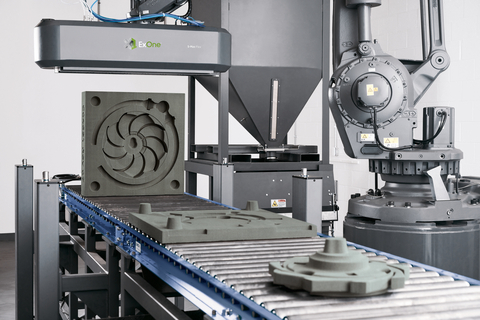Desktop Metal Introduces the All-New S-Max® Flex, a Robotic Additive Manufacturing 2.0 System that Makes Sand 3D Printing Affordable to Foundries Worldwide
- New system joins Desktop Metal’s category-leading ExOne S-Max line of industrial sand binder jetting solutions
- S-Max Flex leverages the combined technology and application expertise of Desktop Metal and ExOne to offer an affordable, precise, and robust tool for foundries stepping into the next era of digital casting
- Designed for turnkey ease of use, S-Max Flex uses Desktop Metal’s patent-pending Single Pass Jetting™ (SPJ) technology to print at high speeds delivering low part costs
- The most affordable sand 3D printer ever offered by the ExOne brand, the S-Max Flex aims to bring sand binder jetting to every foundry
Desktop Metal (NYSE: DM) announced the launch of the ExOne S-Max® Flex, a scalable, large-format binder jetting system that 3D prints sand tooling, which foundries use to quickly cast complex metal designs for the aerospace, automotive, and energy industries, among others.

ExOne, which was acquired by Desktop Metal in late 2021, is the leading digital sand printing solution provider for foundries. The new S-Max Flex combines ExOne’s sand printing expertise in process and materials with proprietary Desktop Metal SPJ technology in an affordable architecture to deliver new value to foundries that have long wanted an S-Max but found the premium price out of reach.
The S-Max Flex will debut at CastExpo 2022, North America’s largest metalcasting trade show, from April 23-26 in Columbus, Ohio. A video highlighting the benefits of the S-Max Flex for early customers, including Alpha Foundry of Wright City, Mo., and D.W. Clark in Taunton, Mass., was released today at www.exone.com/flexvideo.
“To achieve our vision of Additive Manufacturing 2.0, we need to make production 3D printing practical in terms of speed, cost, and material availability for a broad range of applications,” said Ric Fulop, Co-Founder and CEO of Desktop Metal.
“We designed the all-new S-Max Flex from the ground up leveraging SPJ technology with the idea of making premium sand 3D printing accessible to every foundry, so that more companies can take advantage of the benefits of AM 2.0, such as distributed, local production, and remain competitive for the long term.”
The S-Max Flex comes to market at a time of strong demand for castings, along with challenges finding labor. After years of contraction, the U.S. metalcasting industry is experiencing growth as a result of supply chain changes related to the COVID-19 pandemic. A recent survey released by the American Foundry Society shows that 90 percent of responding North American foundries have a positive business outlook and anticipate making capital investments in the next 12 months, including of 3D printers.
Additional early buyers of the new S-Max Flex include Founders Service & Manufacturing Co. Inc. of Deerfield, Ohio, and HTCI Co. of New Carlisle, Ohio.
Details of the S-Max Flex
The S-Max Flex pairs an affordable industrial robot with an all-new end effector printhead design that deposits binder into a 1900 x 1000 x 1000 mm (74 x 39 x 39 in) telescoping build box that grows as the parts are built layer by layer. Additional build box sizes are available up to 4700 x 1000 x 1000 mm (185 x 39 x 39 in), with taller versions available up to 1000 x 2500 x 2400 mm (39 x 98 x 94 in).
Desktop Metal’s high throughput SPJ technology delivers a build rate up to 115 l/h, which offers foundries quick and reliable production to operate more efficiently in times of ongoing labor shortages, as well as a faster return on investment. The S-Max Flex joins the premium S-Max® and S-Max® Pro solutions that are used in foundries worldwide.
The all-new S-Max Flex prints standard silica sand with furan binders and delivers final parts with dimensional accuracy of +/- 0.5 mm. The system comes with several accessories and safety features that are configurable to fit a variety of spaces.
Industries beyond metalcasting are also set to take advantage of the S-Max Flex’s large form factor and ability to binder jet a variety of powders. Infiltrated sand tooling for plastic thermoforming, composite layup, and sacrificial tooling applications are printed today on S-Max machines, along with infiltrated sand consumer products, such as those offered by Sandhelden and Deeptime. Desktop Metal’s Forust brand, which upcycles byproducts of the wood waste stream into consumer designs, will also leverage the new system to print large form factor wood parts at scale cost-effectively. Additional projects are underway printing reclaimed concrete and other materials.
Binder Jetting – the Fastest AM Method for Mass Production
Binder jet 3D printing is widely regarded as the fastest additive manufacturing method for the mass production of functional precision parts. Sand binder jet 3D printing has been used in foundries for more than two decades to create metalcasting tooling cost-effectively and with low turnaround times.
In the binder jetting process, an industrial printhead selectively deposits a binder into a bed of sand particles creating a solid part one thin layer at a time, similar to printing on sheets of paper. 3D printing straight from CAD files enables foundries to eliminate the months-long lead times and high costs of traditional patterns and coreboxes created from wood or metal. The design freedom of additive manufacturing also allows designers to innovate the parts made with the reliable casting process – creating complex, consolidated geometries that enable lightweighting and optimized part performance not possible with traditional processes.
For more information on the ExOne S-Max Flex system, visit www.exone.com.
This content was first published on the Desktop Metal website.

